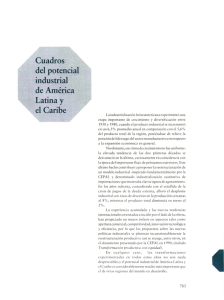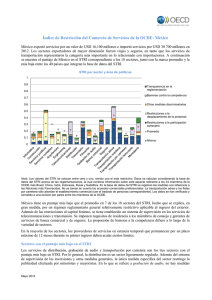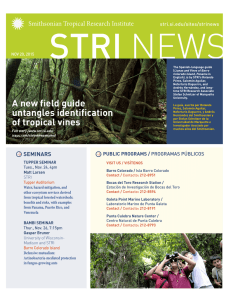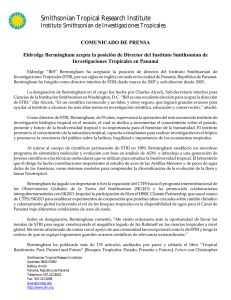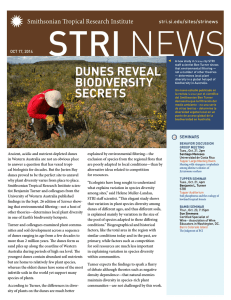comes to panama - Smithsonian Tropical Research Institute
Anuncio
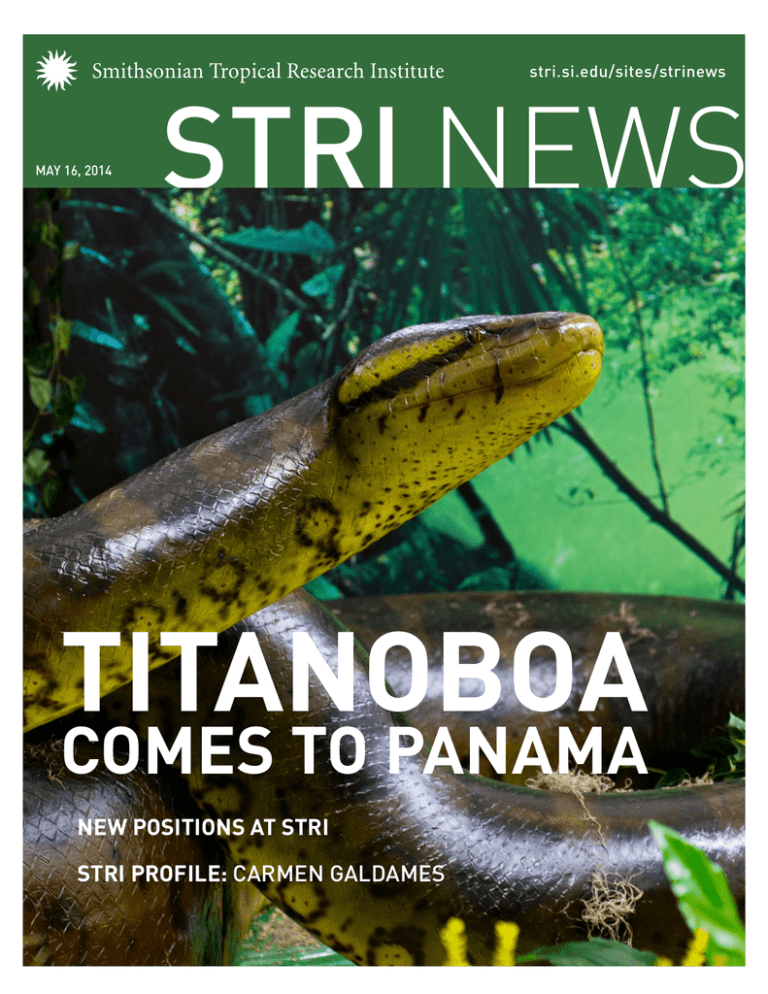
STRI NEWS stri.si.edu/sites/strinews MAY 16, 2014 TITANOBOA COMES TO PANAMA NEW POSITIONS AT STRI STRI PROFILE: CARMEN GALDAMES STRI NEWS stri.si.edu/sites/strinews MAY 16, 2014 A life-sized model of the Titanoboa, created by Kevin Hockley in Canada arrived in Panama this week. Alessandro Medaglia, General Manager of UPS in Panama and Nicaragua, Titanoboa discoverer Carlos Jaramillo, Albrook Mall’s Marketing Director Nadkyi Duque and STRI Acting Director Bill Wcislo spoke at the inauguration of the exhibit at the mall in Panama. Thanks to UPS for donating the shipment of the model and Albrook Mall for exhibit space and publicity. Un modelo de tamaño natural de la Titanoboa, creado por Kevin Hockley en Canadá llegó a Panamá esta semana. STRI opens a new exhibit, a life-sized replica of Titanoboa the 43-foot long prehistoric snake, at Panama’s Albrook Mall, Koala Plaza, from May 16 to June 5. rainforest in the world. They also found fossils of giant turtles and crocodiles, as well as the first known bean plants and some of the earliest banana, avocado and cacao plants. Titanoboa, which lived 60 million years ago, is estimated to have weighed 1.5 tons, and is the largest snake ever found. The exhibit reveals Titanoboa’s lost world and explores the relationship between this massive boa and its living cousin, the boa constrictor, common in Panama today. The content for the exhibit is adapted from: “Titanoboa: Monster Snake,” a collaboration between Smithsonian Institution Traveling Exhibition Service, STRI, the Florida Museum of Natural History at the University of Florida in Gainesville, and the University of NebraskaLincoln. “In order to understand the massive extinctions of tropical fauna taking place today, it is helpful to learn more about tropical environments and extinctions in the past,” said William Wcislo, acting director of the Smithsonian in Panama. “Titanoboa raises many questions: what was the climate like 60 million years ago and why are there no snakes of this size alive today?” The Titanoboa exhibit in Panama was made possible in part by UPS, a global leader in logistics, which transported the model of the serpent, weighing approximately 500 pounds from Toronto, Canada to Panama City, Panama as an in-kind donation equivalent to $4,653.73 in shipping cost. Scientists from STRI and their colleagues discovered remnants of the giant serpent in South America’s largest open-pit coal mine at Cerrejón in La Guajira, Colombia, while unearthing what could possibly be the first “Exhibits like ‘Titanoboa’ educate audiences about our world’s prehistoric origins and the creatures that inhabited our planet during that time. UPS is proud to transport the model and become a facilitator of knowledge,” said Jose Acosta, UPS Americas president of Operations and Public Affairs. Continues on the next page… Alessandro Medaglia, gerente general de UPS en Panamá y Nicaragua, el descubridor de la Titanoboa, Carlos Jaramillo, Nadkyi Duque, Directora de Mercadeo de Albrook Mall y Bill Wcislo, Director Interino de STRI hablaron durante la inauguración de la exhibición en este centro comercial en Panamá. Gracias a UPS por donar el envío del modelo y a Albrook Mall por brindar el área para la exhibición y publicidad. GAMBOA SEMINAR Mon. May. 19, 4pm Emily Francis STRI Gamboa schoolhouse Towards a better understanding of the benefits of high wood density BEHAVIOR DISCUSSION GROUP MEETING Tues., May. 20, 2pm Henry Pollock University of Illinois at Urbana-Champaign Tupper Large Meeting Room Time budgets and behavior patterns of a suite of understory insectivorous birds in Panama TUPPER SEMINAR Tues., May. 20, 4pm Kirsteen MacKenzie STRI and University of Southampton, National Oceanography Centre, UK Tupper Auditorium Indirect ecology: observing fish through their stable isotopes Illustration of Titanoboa cerrejonensis in its environment by Jason Bourque, University of Florida. Credit: Jason Bourque, University of Florida Representacion de la Titanoboa cerrejonensis en su ambiente natural por Jason Bourque de la Universidad de Florida. Crédito: Jason Bourque, Universidad de Florida Albrook Mall, the largest mall in Latin America, generously donated the space for the exhibit in its Koala Plaza where Panama residents and tourists will gather to see the model snake. “Without a doubt, this initiative that we’re supporting has immediate, positive social impact. Mall visitors will enjoy an educational experience about past extinctions,” said Nadkyi Duque, Albrook Mall Marketing Director. After the exhibit closes on June 5, the snake will travel to venues in Colombia including the the Museo Arqueologico de Pueblos Karib at Universidad del Norte in Barranquilla, the Instituto Alexander von Humboldt in Villa de Leiva, and the Descubre Guajira Museo Centro Interactivo in Albania, Guajira. This exhibit is also sponsored by the Corporación Geologica ARES in Colombia. https://www.facebook.com/SmithsonianPanama?ref=hl LA TITANOBOA LLEGA A PANAMÁ El Smithsonian en Panamá inaugura a partir del 16 de mayo al 5 de junio la exhibición “Titanoboa,” una réplica de tamaño natural de la serpiente prehistórica de 43 pies de largo la cual estará en el Centro Comercial Albrook, pasillo del Koala. La “Titanoboa”, que se estima pesaba 1.5 toneladas, fue la serpiente más grande del mundo y vivió hace sesenta millones de años. La exhibición revelará el mundo perdido de la “Titanoboa” y explorará la relación entre esta enorme boa y su prima viviente, la boa constrictor, común en el Panamá del presente. “Con el fin de entender mejor las extinciones masivas de la fauna STRI NEWS, MAY 16, 2014 tropical que se dan hoy día, es interesante el conocer más sobre los ambientes tropicales y las extinciones en el pasado”, comentó William Wcislo, director interino del Smithsonian en Panamá. “La ‘Titanoboa’ plantea muchas interrogantes: ¿cómo era el clima hace 60 millones de años y por qué en el presente no hay serpientes vivas de este tamaño?” Científicos del Smithsonian y sus colegas encontraron los restos de la serpiente gigante mientras llevaban a cabo estudios en la mina de carbón a cielo abierto más grande de Sudamérica en Cerrejón, localizada en La Guajira, Colombia. Los científicos desenterraron lo que podrían ser organismos de la primera selva tropical en el mundo. También encontraron fósiles de tortugas gigantes y cocodrilos, así como las primeras plantas de la familia del frijol conocidas y algunas de las plantas más antiguas de banano, aguacate y cacao. El contenido de esta muestra es una adaptación de la exhibición: “Titanoboa: Monster Snake”, una colaboración entre el Servicio de Exhibiciones Itinerantes de la Institución Smithsonian, el STRI, el Florida Museum of Natural History de la Universidad de Florida en Gainesville y la Universidad de Nebraska-Lincoln. La exhibición Titanoboa que se presenta en Panamá fue posible gracias a los aportes de UPS, líder global en logística, quienes transportaron el modelo de la serpiente que pesa aproximadamente 500 libras desde Toronto, Canadá, hasta la ciudad de Panamá, Panamá en calidad de donación en especie equivalente a $4,653.73 por costos de envío. “Exhibiciones como ‘Titanoboa’ educarán al público sobre los orígenes prehistóricos de nuestro mundo y de las criaturas que habitaron nuestro planeta durante ese tiempo. UPS tiene el orgullo de haber transportado el modelo y de convertirse en facilitadores del conocimiento”, comentó José Acosta, presidente de Operaciones y Asuntos Gubernamentales de UPS Región de las Américas. Albrook Mall, el mall más grande de Latinoamérica, generosamente puso a disposición el espacio para la exhibición en la Plaza del Koala la cual será el escenario donde nacionales y turistas se darán cita para apreciar tan impactante exhibición. “Sin duda alguna, esta iniciativa la apoyó nuestro centro comercial de manera inmediata por su impacto positivo en la sociedad, al entregar a los asistentes una muestra educativa de las extinciones pasadas”, expuso Nadkyi Duque Directora de Mercadeo del Mall. Luego de la clausura de la exhibición el 5 de junio, la serpiente viajará a distintos lugares de Colombia, incluyendo el Museo Arqueológico de Pueblos Karib de la Universidad del Norte en Barranquilla, al Instituto Alexander von Humboldt en Villa de Leiva y al Museo “Descubre Guajira” en el Centro Interactivo en Albania, Guajira. Esta muestra también es patrocinada por la Corporación Geológica ARES de Colombia. https://www.facebook.com/SmithsonianPanama?ref=hl Smithsonian paleobotanist Carlos Jaramillo demonstrates the difference in size between the vertebra of a modern boa (right) and the fossil vertebra of the Titanoboa discovered in Colombia El paleo-botánico del Smithsonian Carlos Jaramillo muestra la diferencia en tamaño entre las vértebras de una boa moderna (derecha) y la vértebra fósil de la Titanoboa descubierta en Colombia. Designed by Lina Gonzalez at STRI and constructed by Alberto Castillo and Ivan Patiño, this exhibit will be home to the Titanoboa model in the Koala Plaza of Albrook Mall through June 5. Diseñada por Lina González en STRI y construida por Alberto Castillo e Iván Patiño, esta exhibición será el hogar del modelo de la Titanoboa en el pasillo del Koala en Albrook Mall hasta el 5 de junio. CHANGING ORGANIZATIONAL CHART CAMBIO EN ORGANIGRAMA Thanks to the efforts of STRI’s Human Resources and Director’s Offices, in addition to insuring that everyone got a raise this year, a number of people have changed positions in an effort to improve our abilities to support STRI’s science mission. Gracias a los esfuerzos de la oficina de Recursos Humanos de STRI y la oficina del Director, además de asegurar que todos obtuvieran un aumento de sueldo este año, un número de personas ha cambiado de posición en un esfuerzo por mejorar nuestras capacidades para apoyar la misión científica del Instituto. Mercedes Best, HR Specialist Thayra Hernández, Procurement Technician Dafne Ruiz, Bookstore Administrator Yohany Candanedo, Travel Technician Jennifer Campuzano, Fund Manager Elisabeth King, Communication Supervisor Lina González, Design Supervisor Ana Matilde Ruiz, Special Events Supervisor Damaris Martínez, Travel Supervisor Adriana Bilgray Academic Programs Manager Wendy Jiménez HR Supervisor Jorge Alemán Graphic Design Specialist Roberto Borrell Traffic Supervisor Richard Cooke Senior Level Staff Scientist Angela Cruz Accounting Supervisor Gilberto Batista Kitchen Supervisor (BCI) Rafael Batista, Boat Operations Supervisor (BCI) Luis Zambrano, Boat Maintenance Supervisor (BCI) Carlos Caballero IT Specialist Rivieth De Liones Asistente Administrativa 1 PLANT DIVERSITY BEYOND THE NUMBERS LA DIVERSIDAD DE PLANTAS MÁS ALLÁ DE LOS NÚMEROS Carmen Galdames could easily describe Panama’s plant diversity in terms of the thousands of specimens stored in STRI’s herbarium. As lead technician since 1994 of STRI’s herbarium, under STRI staff scientist Mireya Correa who has been in charge since 1987, Galdames has personally collected and catalogued many of the plants it contains. However, instead of citing figures, Galdames encourages people to perceive and understand plant biodiversity by cultivating a direct relationship with the flora around us. Carmen Galdames podría fácilmente describir la diversidad vegetal en términos de los miles de especímenes de plantas almacenados en el herbario del Smithsonian en Panamá. Como técnico principal de éste herbario desde 1994, bajo la dirección de la científica permanente Mireya Correa, quién está a cargo desde 1987 — colectó y catalogó personalmente muchas de las plantas que contiene. Sin embargo, en lugar de citar números, Galdames alienta a los visitantes a percibir y entender la diversidad a través del cultivo de una relación directa con la flora a nuestro alrededor. “Regularly we hear and repeat the word ‘biodiversity’ and its numbers, but this doesn’t mean much for many people,” said Galdames, while she removes specimens from the collection and shows herbarium visitors the multitude of characteristics that allow botanists to identify species. “As a botanist, I feel indebted. I learned to appreciate plants through knowledge. It’s this knowledge that makes people value them.” “A menudo escuchamos e incluso repetimos la palabra biodiversidad y sus números, pero esto no significa mucho para la gente”, comentó Galdames, mientras extraía especímenes de la colección y motivaba a los visitantes a apreciar algunas de las características que permiten a los botánicos identificar las especies. “Como botánica, me siento en deuda. Aprendí a apreciar las plantas a través del conocimiento. Es este conocimiento el que hace que la gente las valore.” “This process of raising awareness and education ultimately leads to conservation,” she said. “Este proceso de sensibilización y educación es el que finalmente conduce a la conservación”, comentó. Galdames studied Botany at the University of Panama. Before joining STRI, she worked with Mahabir Gupta at the University’s Faculty of Pharmaceutical Sciences. Galdames’ work included collecting and processing plants that would be used in phytochemical analyses in various national and international projects. Galdames collaborated in the development of ethnobotanical studies and in the compilation of information from 21 countries for a volume on 270 medicinal plants from Latin America. Galdames estudió Botánica en la Universidad de Panamá. Antes de unirse al Smithsonian, trabajó con el Dr. Mahabir Gupta, en la Facultad de Farmacia de dicha Universidad. Su trabajo incluyó colectar y procesar las plantas que serían objeto de análisis fitoquímicos en diversos proyectos nacionales e internacionales. Colaboró en el desarrollo de estudios etnobotánicos y en la compilación de información proveniente de 21 países para el libro “270 Plantas Medicinales de Iberoamérica”. STRI NEWS, APRIL 4, 2014 Photo: Sean Mattson “The more I learned, the more it fascinated me,” said Galdames, who tirelessly stresses the importance of accurately identifying medicinal plants and their chemical properties before using them. “Cuanto más aprendía, más me fascinaba”, comentó Galdames, quien incansablemente hace hincapié en la importancia de identificar con precisión las plantas medicinales y sus propiedades químicas antes de usarlas. ARRIVALS PUBLICATIONS Daniel Lamont Van Hall Larenstein What are the consequences of shared enemies for the community structure of a tropical forest? Barro Colorado Island Tess Bender Stephen Yanoviak, Joseph Bradley, Amanda Winters and Perri Eason The University of Western Australia University of Louisville Ecology and Behavior of Arboreal Arthropods Barro Colorado Island Maxwell Brown Connecticut College Rutgers University Effects of hypoxia on the distribution of planktonic larvae in the Tropical Caribbean Bocas del Toro Boris Baer Mariya Zhukova and Sarah Cherasse University of Copenhagen Evolutionary ecology of fungus growing ants Gamboa DEPARTURES Roberto Ibáñez To Front Royal, VA To participate in the course “Estimating Animal Abundancy and Occupancy” (MCCS 0511) at the Smithsonian-Mason School of Conservation Tania Quiel To San Francisco, CA To attend the Cisco Live Conference 2014 Jefferson Hall To Storrs, CT To attend PARTNERS workshop Héctor Guzmán To Cali, Colombia To visit micro-mechanical shop to manufacture transmitter anchor tips Rachel Collin To Bocas del Toro For the project: Effects of hypoxia on the distribution of planktonic larvae in the tropical Caribbean [email protected] Questions/comments Guzman, H. M., Condit, R. S., Perez-Ortega, B., Capella, J. J. and Stevick, P. T. 2014. Population size and migratory connectivity of humpback whales wintering in Las Perlas Archipelago, Panama. Marine Mammal Science, doi:10.1111/mms.12136 Leigh, E. G., Jr. 2014. [Review]: Alan Feduccia’s Riddle of the Feathered Dragons: what reptiles gave rise to birds?. Evolution: Education and Outreach, 7: 0 doi:10.1186/s12052-0140009-0 Effects of hypoxia on the distribution of planktonic larvae in the Tropical Caribbean Naos Marine Lab Jacob Slusser To Los Santos, Panama To visit research and training sites, collect data and maintenance at Achotines Clay, N. A., Yanoviak, S. P. and Kaspari, M. 2014. Shortterm sodium inputs attract microbi-detritivores and their predators. Soil Biology and Biochemistry, doi:10.1016/j. soilbio.2014.04.021 Preguntas/comentarios @stri_panama #smithsonian McDonald, K. A., Collin, R.and Lesoway, M. P. 2014. Poecilogony in the caenogastropod Calyptraea lichen (Mollusca: Gastropoda). Invertebrate Biology, doi:10.1111/ ivb.12057 Osazuwa-Peters, O. L., Wright, S. J. and Zanne, A. E. 2014. Radial variation in wood specific gravity of tropical tree species differing in growth–mortality strategies. American Journal of Botany, doi:10.3732/ ajb.1400040 Roberts, T. R. 2014. Wallago Bleeker, 1851 and Wallagonia Myers, 1938 (Ostariophysi, Siluridae), Distinct Genera of Tropical Asian Catfishes, with Description of Wallago maemohensis from the Miocene of Thailand. Bulletin of the Peabody Museum of Natural History, 55(1): 35-47. doi:10.3374/014.055.0103 Rocha, R. and Lopez-Baucells, A. 2014. Opportunistic predation by Crested Owl Lophostrix cristata upon Seba’s Short-tailed Bat Carollia perspicillata. Revista Brasileira De Ornitologia, 22(1): 35-37. Romero Valero, I. 2014. Palynological Evidence for the Paleoenvironmental History of the Miocene Llanos Basin, Eastern Colombia. South Orange, New Jersey: Seton Hall University Dissertations and Theses (ETDs). Paper 1956. 1 page.
